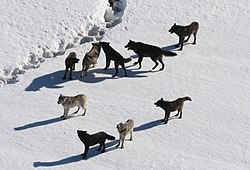| Yellowstone | |
|---|---|
 Series title card from UK broadcast | |
| Also known as | Yellowstone: Battle for Life |
| Genre | Nature documentary |
| Narrated by | Peter Firth |
| Composer | Edmund Butt |
| Country of origin | United Kingdom |
| Original language | English |
| No. of episodes | 3 |
| Production | |
| Executive producer | Mike Gunton |
| Producers | Andrew Murray Nathan Budd Paul D. Stewart |
| Running time | 50 minutes |
| Production companies | BBC Natural History Unit Animal Planet |
| Original release | |
| Network | BBC Two |
| Release | 15 March – 29 March 2009 |
Yellowstone is a BBC nature documentary series broadcast from 15 March 2009. Narrated by Peter Firth, the series takes a look at a year in the life of Yellowstone National Park, examining how its wildlife adapts to living in one of the harshest wildernesses on Earth. Yellowstone debuted on BBC Two at 8:00pm on Sunday 15 March 2009 and has three episodes. Each 50-minute episode was followed by a ten-minute film called Yellowstone People, featuring visitors to the Park and locals who had assisted the production team. The series was the channel's highest-rated natural history documentary in over five years with audiences peaking at over four million. [1]
Contents
In the United States, an edited version of the series was broadcast under the title Yellowstone: Battle for Life. It aired as a two-hour TV special, and premiered on Animal Planet on 22 March 2009.
The series was one of the most popular titles at BBC Worldwide's annual market for international clients with pre-sales to nine territories including Spain (Canal+), Germany (WDR), Russia (Channel 1) and Italy (RTI). [2]


